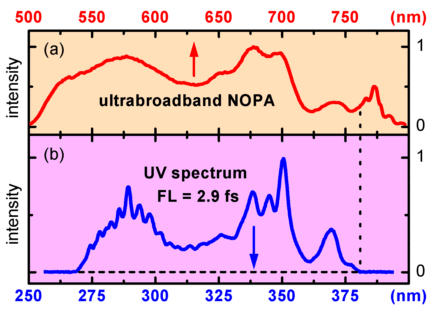|
|
 |
|
|  |
 Extremely short ultraviolet light pulses Extremely short ultraviolet light pulses
Ultraviolet optical pulses with a duration of 7 fs are generated by high-order achromatic frequency doubling the output of a NOPA. The highly stable pulses are widely tunable and will be of enormous use for
-
time-resolved spectroscopy with highest resolution
-
-
broadband detection of transient spectra
-
electronic dephasing measurements
-
CE-phase sensitive experiments like attosecond pulse generation
For the generation of the extremely short UV pulses four aspects are essential: (1) generation of broadband visible pulses, (2) an extremely broadband and efficient SHG scheme, (3) a careful management of the first and higher order chirp and (4) the full pulse characterization with ZAP-SPIDER.
|
High-order achromatic phase matching
To generate few cycle UV pulses by collinear frequency doubling the simultaneous phase matching of all spectral components would require an extremely thin nonlinear crystal, e.g. a thickness of less than 5 µm for a 5 fs pulse. Besides the difficulties in manufacturing such a thin crystal, the conversion efficiency would be minimal.

Solution: achromatic phase matching! A broadband light pulse is angularly dispersed such that each frequency component propagates in the nonlinear crystal with its individual phase matching angle. The angular dispersion matches the internal phase matching behavior of the nonlinear crystal (BBO) to high order. Furthermore the conversion occurs in a common focus of all spectral components to assure the highest doubling efficiency.
 Generation of extremely broadband UV spectra Generation of extremely broadband UV spectra
By choosing a suitable combination of focal length and prisms of appropriate material and apex angle the incident angle can be matched to the phase matching behavior of the nonlinear crystal to high order. Prisms contrary to gratings have the correct sign of second order dispersion needed for phase matching the typical nonlinear crystals.
In our experimental setup (see below) spectra with a Fourier limit of 2.9 fs are generated in a BBO crystal as thick as 360 µm. The natural bandwidth of the crystal is improved by a factor of 80 and simultaneously a frequency doubling efficiency as high as 20% is achieved.
|
Generation of 7-fs ultraviolet pulses
The visible pulses are dispersed by two fused silica prisms and focused to a common spot with an off-axis parabolic mirror (OAP). The UV spectrum is recollimated with a second off-axis parabolic mirror (OAP) and recombined by calcium fluoride prisms. A 4-f setup with a deformable end mirror compensates for higher-order chirp.
The full achromatic SHG scheme forms a prism compressor with a conversion of the visible spectral components to the UV in the middle. The whole setup is designed to generate compressed UV pulses from the chirped NOPA output. We fully characterize the spectral phase and thereby the temporal structure of the UV pulses with ZAP-SPIDER.
A typical UV pulse shape is shown above. The measured pulse duration of 7.1 fs is within 15% of the Fourier limit. The pulse consists of only seven periods of the electric field. |
|
| |
|
|  |
"Achromatic second harmonic generation: tunable ultraviolet pulses with sub-10 fs duration"
P. Baum, S. Lochbrunner, and E. Riedle
Ultrafast Phenomena XIV, T. Kobayashi, T. Okada, T. Kobayashi, K. Nelson, S. De Silvestri, eds. (Springer-Verlag, Berlin, 2005), 79 - 81
Details
"Full characterization of ultraviolet and visible 10-fs pulses with zero-additional-phase SPIDER"
P. Baum, S. Lochbrunner, and E. Riedle
Ultrafast Phenomena XIV, T. Kobayashi, T. Okada, T. Kobayashi, K. Nelson, S. De Silvestri, eds. (Springer-Verlag, Berlin, 2005), 130 - 132
Details
"Generation of tunable 7-fs ultraviolet pulses:
achromatic phase matching and chirp management"
P. Baum, S. Lochbrunner, and E. Riedle
Appl. Phys. B 79, 1027 - 1032 (2004)
Details
"Tunable sub-10-fs ultraviolet pulses generated by achromatic frequency doubling"
Peter Baum, Stefan Lochbrunner, and Eberhard Riedle
Opt. Lett. 29, 1686 - 1688 (2004)
Details
| | |

